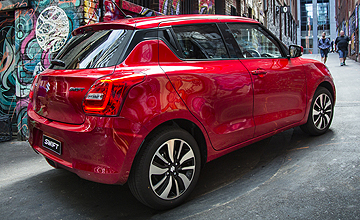BY TUNG NGUYEN | 5th Jun 2017

With the expectation that the Swift will again becoming Suzuki’s sales-leading model, overtaking the popular Vitara small-SUV, the new light car will need to impress against the likes of the Mazda2, Ford Fiesta and Kia Rio.
Luckily for Suzuki, it has delivered a competent, fun and affordable package which should draw the eye of first-car buyers and light-car lovers alike, as well as being a worthy successor to the Swift nameplate.
The fresh five-door Swift retains a similar style to its predecessor, opting for a cute and bubbly hatchback design that is pleasing to the eye.
Suzuki has also opted to move the rear door handles from the traditional position to up along the C-pillar, similar to the styling flourish of the Nissan Juke, Toyota C-HR and Honda HR-V crossovers.
While we appreciate what Suzuki is trying to achieve with the door handle design, we only wish they would finish the C-pillar in a gloss black to match the A- and B-pillars as well.
As it stands, our eyes are drawn directly towards the ‘hidden’ door handle thanks to the matte black plastic finish, which contrasts obviously against the metallic and pearl paintwork.
Inside the Swift, Suzuki has delivered a functional but polished cabin with little details to elevate it above its competitors.
Built on the Heartect platform, the seating position in the new Swift sits lower than before and the reworked front seats add more bolstering and support.
Adding to the sporty feel, the Swift also has a leatherette D-shaped steering wheel across the range– a feature most often seen on sportscars and hot hatches, not budget light cars – and a dashboard which is angled five degrees towards the driver for an ensconced driving sensation.
Our first test car, the base GL five-speed manual, felt bare bones inside with the only equipment of note being a Bluetooth-compatible head-unit.
As a price leader, it is understandable that the $15,990 before on-roads GL manual misses out on some gear, but not including technology such as a reversing camera, autonomous emergency braking (AEB) and a touchscreen infotainment system – which its cheaper competitors offer as standard – won’t help the Swift’s cause.
Fortunately, the 66kW/120Nm 1.2-litre four-cylinder engine does go some way to making up for the lack of standard equipment.
We tested the car around the Yarra Valley region in Victoria, driving through the country town of Healesville and the roads around Black Spur.
Punchy and rev-hungry, the base Swift is happy to motor around town and is more than eager to zip in and out of traffic at everyday speeds.
However, stretching its legs out onto a country road – and freeway we imagine – the Swift can feel a little asthmatic, with long gears and slow acceleration times over 60km/h.
Steering feels direct and connected though, so the Swift has no problem in the bends and the sub-900kg kerb weight helps contribute to the overall fun feel of the car, as does MacPherson strut front suspension. Rear suspension is taken care of with a torsion beam with coil springs.
While the entry-level Swift is a commendable steer – we’d liken it to the fun factor of the fan-favourite Mazda2 – we’d have to recommend picking up the higher-spec GL Navigator for $17,990.
The extra $2000 will net buyers a continuously variable transmission (CVT), as well as a bevy of more gear including a 7.0-inch touchscreen with satellite navigation, Android Auto and Apple CarPlay connectivity, 16-inch alloy wheels and a reversing camera.
Safety-conscious buyers can even opt for a $1000 Safety Pack which bundles AEB, an LCD display screen nestled between instrumentation, lane departure warning and adaptive cruise control (ACC) to the light car, making this version the cheapest car on the market with ACC yet.
However, while Suzuki is to be commended for packing such high levels of safety equipment onto its Swift, it should also be noted that its competitors, including the Mazda2, include technologies such as AEB as standard across its range.
With AEB quickly becoming the must-have safety technology, we reckon Suzuki should have included the system across its three-variant range.
Moving up to the flagship $22,990 GLX Turbo, power is delivered by an 82kW/160Nm 1.0-litre turbocharged three-cylinder – the same one found in the top-spec Baleno model.
The increase in performance is definitely welcomed as Suzuki has produced such an engaging and dynamic chassis, but we can’t help but wonder what an even more powerful Swift would be like to steer – perhaps a Swift Sport version down the track?We also think the GLX would be an even more engaging drive paired with a manual gearbox, but it remains an auto only option.
The increase in price also nets more features on top of the GL Navigator with Safety Pack, including automatic air-conditioning, automatic LED headlights and rear disc brakes.
We did also find that road noise in the GLX Turbo was a little more noticeable, with lower profile tyres fitted to the 16-inch wheels, but it never reached the point of annoyance or even inconvenience.
With a price rise of $4000 – or an increase of around 21 per cent – we still think the GL Navigator hits the sweet spot of price, equipment and performance.
All versions of the new Swift feature a 242 litre capacity boot with split-fold 60:40 rear seats which can stow to increase loading to 556L.
While more than ample for a few overnight bags, the bottom of the Swift’s boot is sunken and we only wish the floor was level with the rear hatch opening to make stowing luggage easier.
Overall though, Suzuki’s latest entrant into the light-car segment is a definite winner that should emerge as a buyer favourite.
A fun and effervescent car brimming with personality and equipment (at least on higher-grade versions), the Swift is back and better than ever.